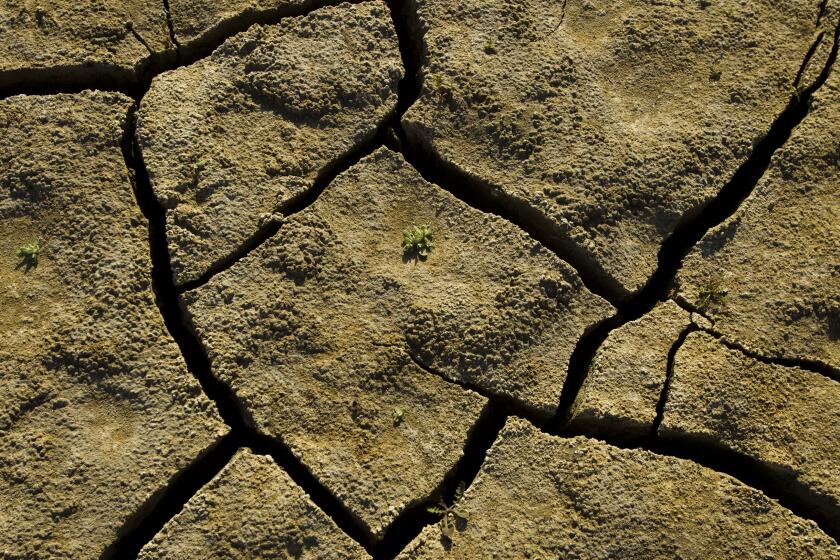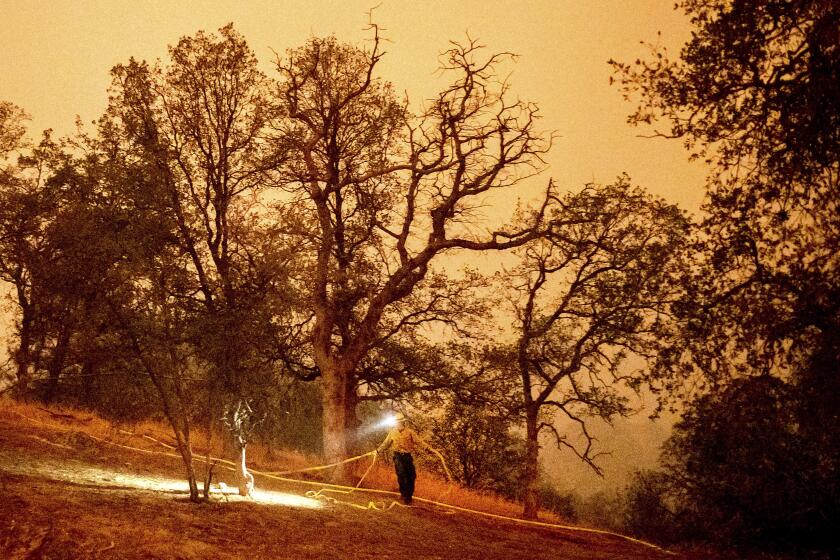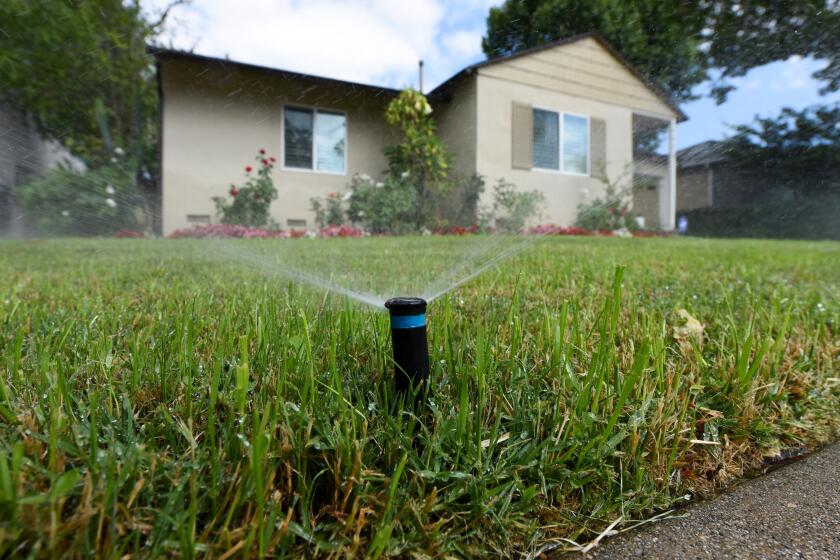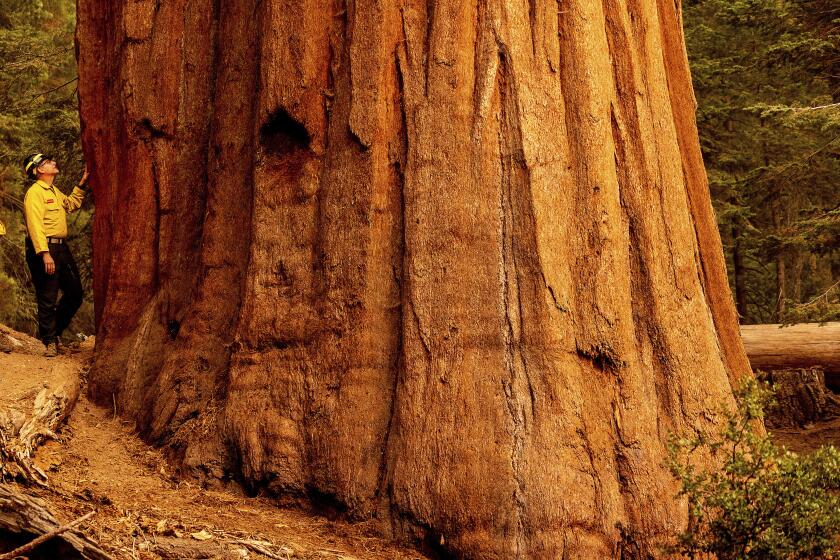Newsom signs $15-billion package to fight climate change, wildfire and drought

- Share via
Standing before a foil-wrapped, fire-proofed monument in Sequoia National Park amid a haze of wildfire smoke, Gov. Gavin Newsom on Thursday signed a $15 billion climate package for California, the largest such investment in state history.
As ash from the nearby KNP Complex fire rained from an opaque sky, Newsom outlined the details of the package, which included investments in drought response, forest management and climate risk mitigation.
California in recent months has been hit with record-breaking heat, devastating drought and a wildfire season that has seen more than 2.35 million acres burned across the state — a disastrous convergence of events that has been fueled by the burning of fossil fuels and threatens to become endemic to the region.
“We feel a deep sense of responsibility here in the state of California because of the smash-mouth realities of climate change,” Newsom said. “Not just the issues of the acuity and frequency and duration of these wildfires, but also what’s happening with this mega-drought over the entire West Coast of the United States.”
California has entered another drought. But depending on who you ask, the last one may have never really ended.
The announcement arrived in tandem with Climate Week and the run-up to the United Nations Climate Change conference in Glasgow, Scotland, this fall.
Big-ticket items in the package include $5.2 billion for drought response and water resilience; $3.7 billion for issues like extreme heat and sea level rise; $3.9 billion for electric vehicle investment and infrastructure; $1.5 billion for wildfire response and forest resilience, and $1.1 billion for sustainable agriculture.
The aggregate items stem from the state’s larger $262.6-billion budget, which also encompasses COVID-19 pandemic relief and a sweeping effort to address homelessness, among other top priorities.
But the effects of climate change on Thursday seemed most acute as Newsom signed the legislation under smoke-filled skies. The KNP Complex and the nearby Windy fires have for days threatened California’s towering sequoia trees, which for many years were believed to be nearly impervious to fire.
Last week, officials were seen wrapping the General Sherman tree — known as the largest tree in the world by volume — in fire-resistant foil; a wrenching image in a fire-addled state.
“Here we are with these sentinels to our history,” Newsom said. “You’ve got trees that quite literally date back to over 3,300 years ago. You can’t rebuild a giant sequoia ... and that’s why we’re here with a deep sense of urgency.”
The 8,940-acre KNP Complex fire is within striking distance of Sequoia National Park’s Giant Forest, home to the largest tree on Earth, officials said.
But it’s not only wildfire that has brought the region to its knees. California and four other Western states just recorded their hottest summer on record, according to the National Oceanic and Atmospheric Administration.
One heat wave that blanketed the Pacific Northwest in June claimed the lives of hundreds, including immigrant farmworkers and the elderly. An estimated 1 billion sea creatures died because of heat off the coast, and the Sacramento River is facing a “near-complete loss” of young Chinook salmon because of abnormally warm waters.
And worsening drought conditions have seen many of the state’s reservoirs shrink to near-record levels. Rainfall this year was a pittance and the snowpack, at its deepest, was only 59% percent of average, the California Department of Water Resources said.
Conditions became so dire that officials in August had to shut down a major hydroelectric power plant at Lake Oroville for the first time since its completion in 1967 on account of low water.
Newsom declared a drought emergency in April and expanded it to 50 counties in July, pleading with residents to voluntarily cut back on water consumption by 15%. Water officials in Southern California similarly declared a supply alert in August, urging residents to conserve vital resources.
So far, few have heeded that call, with Californians on average reducing water use by only 1.8% statewide during July.
Despite a request by Gov. Gavin Newsom to voluntarily reduce water use by 15%, Southern California has yet to start conserving, figures show
But Newsom’s consternation on Thursday was aimed not at residents but lawmakers in Washington, including many who so far have shown inaction on the issue of climate change.
“What more evidence do you need of a world that’s heating up, our kids that are choking up, and a growing number of acres and communities and states burning up?” he said.
Newsom also criticized former President Trump for failing to fight climate change, noting that Trump said the answer to California’s conflagrations was “buying more rakes.”
It is increasingly important for the state to work closely with the federal government to manage its worsening wildfires. The federal government owns 57% of the forest land in California, while the state owns just 3%. The rest is in private hands.
Among the top priorities moving forward will be forest management, Newsom said — including a renewed emphasis on prescribed burns, which have been credited with helping protect General Sherman and other sequoias in the Giant Forest from the flames of the KNP Complex fire.
Calling Thursday’s legislation a “landmark bill,” assemblyman Richard Bloom (D-Santa Monica) said wildfire prevention and forest health are of critical importance.
“In the past, almost all of our funding to address wildfire has been to address suppressing the wildfire,” he said — something fire scientists have said led to an overabundance of vegetation that is now fueling many fires. “But we’ve spent very, very little” on prevention.
Crews have used controlled burns, protective foil and other protective measures to guard Sequoia National Park.
Natural Resources Secretary Wade Crowfoot said that much of the spending is necessary to cope with climate impacts that are coming sooner than expected, and which scientists hadn’t predicted to occur until decades from now. “We believed that this level of adaptation was decades into the future,” Crowfoot said.
But that has pushed the administration to do more to reduce carbon pollution and to keep “people and natural places safe from climate change. So we no longer have the luxury of treating climate adaptation like planning.”
Lauren Sanchez, the governor’s senior climate advisor, described the billions in spending over the next three years as a new phase in the state’s battle against climate change, saying Newsom has asked her and other leaders to “manage this crisis like the emergency it is.”
“It’s time to step up and meet this moment,” Sanchez said. “It’s time to stop talking and do what is required to leave our children the livable planet they so deserve.”
Not everyone believed the state was doing enough however.
“Fifteen billion dollars is a lot of money, but if the Governor really wants to future-proof California as he said, then he must know that throwing money at the problem while continuing to approve new fossil fuel permits that are driving the climate chaos, is nonsensical,” said Amy Moas a senior climate campaigner for Greenpeace. “It is like trying to mop up an overflowing bathtub without first turning off the faucet.
On Thursday, Newsom also acknowledged that six of the seven largest wildfires in California have occurred since 2020, noting that “something is happening to the plumbing of the world.”
Speaking about his childhood in California, the governor appeared choked up as he described some of the recent devastation in the state, including the Dixie fire’s leveling of the town of Greenville, and the Caldor fire’s destruction of Grizzly Flats.
“You can’t deny your own eyes,” he said, referring to those who question climate science. “This is not debatable any longer.”
The twin blazes of the KNP Complex and the Windy fires on Thursday had burned more than 75,000 acres combined, spurring new evacuations for nearby residents as crews scrambled to protect homes and giant sequoias.
The emerging Fawn fire in Shasta County prompted its own evacuations on Thursday as it grew to more than 1,000 acres, spewing a massive plume of smoke over the dried out hills.
Staff writer Taryn Luna contributed to this report.
More to Read
Sign up for Essential California
The most important California stories and recommendations in your inbox every morning.
You may occasionally receive promotional content from the Los Angeles Times.















